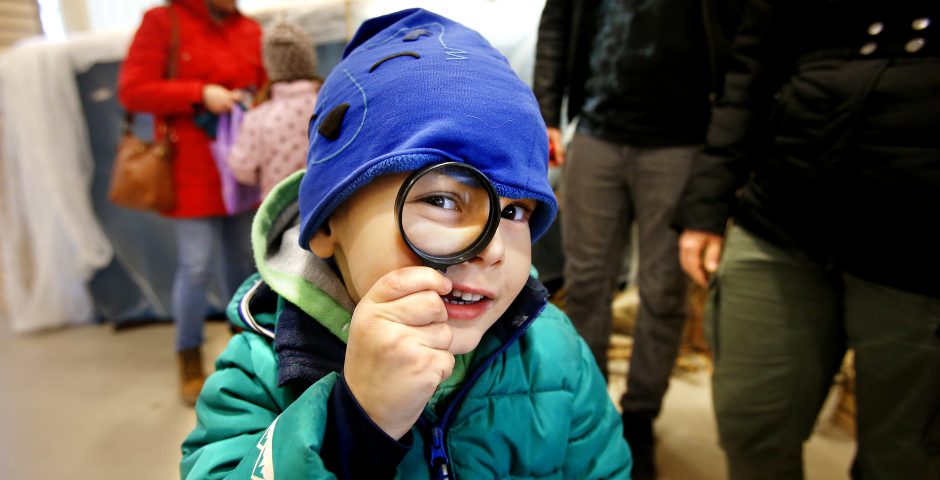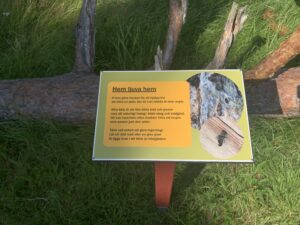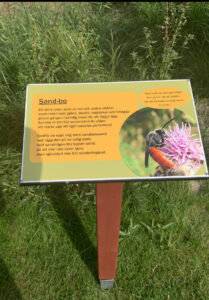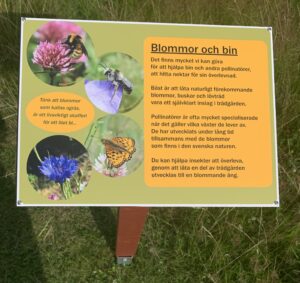
Exhibition
Exhibitions
At the start of each year, we present a major photo exhibition, where nature is depicted from a range of angles. We also have a permanent outdoor exhibition about pollinators.
Outdoor Exhibition
Discover our permanent outdoor exhibition about pollinators, “Pollinators – Small Creatures of Great Value.”

Home Sweet Home
We can do a lot to help bees find a place to nest for their young.
The best thing is to let dead trees and branches remain a natural part of both the forest and the garden. This way, thousands of different insects can find a nook that suits their species.
Think how easy it is to do nothing!
Let a dead tree or a large branch lie in a corner of the garden.

Do Your Part
Do you want to help create a good place for wild bees to lay their eggs? Take a piece of wood or a bundle of bamboo tubes.
Different species of bees need different sizes of holes, ranging from 3 to 12 mm in diameter. Make sure the holes have a back and are not drilled all the way through. The holes should be at least 7
cm, preferably 15 cm, deep so that birds cannot reach and eat the bee larvae.Place it in a protected location!

Build A Nest
When there is a shortage of dead trees with holes, we can help wild bees and other insects by building insect hotels.
Perhaps calling it a “hotel” is a bit misleading. It’s not about a holiday stay, but rather providing an emergency home.
Nonetheless, it’s wonderful that we can do something to thank our pollinators for their invaluable help!

Many species of bees must build nests in sand to survive and not become extinct.

Nest In Sand
A large number of species of bees and other wasps with names like cuckoo bees, blood bees, sand wasps, and bee beetles dig tunnels in sandy soil to lay their eggs. Perhaps this is the summer you choose to start your own sand nest in your yard!
Get a substantial pile of sandbox sand and place it in a sunny spot. Keep the sand pile slightly disturbed so it doesn’t become overgrown, but of course, don’t let it get trampled.
Quote: “Those fortunate enough can dig a bit in the area to expose sandy soil for the bees”.

Pollinators – Small Creatures of Great Value
In the past, there were plenty of nesting sites and food sources for the 300 species of bees living in Sweden. However, today there is a shortage of both homes and suitable flowers. More than 30% of all Swedish bee species are at various levels of extinction risk. Other pollinating insects have also declined significantly. Action is needed for biodiversity, as well as to ensure essential pollination of crops, fruit, and berries.
Here are some tips on how you can help these valuable little creatures.
Mariebergsskogen AB and the Municipality of Karlstad developed the exhibition as part of a LONA project, which meant that government grants for local conservation projects helped finance it. Exhibition producer: Syster Skog and Alice Hultdin.
Photography: Sven-Åke Berglind, Linda Ferm, Lars Pettersson, Julia Westergren, and Dan Mangsbo.

Butterfly Restaurant
Humans have significantly impacted the environment, leading to a decrease in wildflowers and their numbers. To show our appreciation for these vital pollinators, why not create a butterfly-friendly garden?
Fill your garden with a variety of plants that bloom at different times throughout the year. This ensures that there will always be something for the bees and butterflies to enjoy, providing them with a continuous source of food.

Butterfly Bar
Every initiative counts!
A pot of nectar-giving flowers on your balcony, combined with a thousand other balconies, can become a vast meadow of flowers!

Flowers And Bees
There is much we can do to help bees and other pollinators find the nectar they need to survive.
The best approach is to let naturally occurring flowers, shrubs, and deciduous trees be an integral part of your garden.
Pollinators are often highly specialized regarding which plants they rely on. They have evolved over a long time alongside the flowers found in Swedish nature.
You can help insects survive by allowing part of your garden to develop into a blooming meadow.
Consider that flowers labeled as weeds are a crucial pantry for a tiny bee…
Photo Exhibition
The photo exhibition by photographer Susanne Walström, currently on display at Naturum, is called “Black Lava Fairy Tale.”
Over ten years ago, Susanne Walström traveled to Iceland for a week-long riding expedition. She and ten other riders set out on Icelandic horses through the Icelandic wilderness, far from tourist paths, in a landscape unchanged since the old Icelandic sagas were written. The group brought 40 Icelandic horses that roamed freely and followed them. Susanne became increasingly fascinated by these horses and started photographing them. Her fascination grew into a passion that made her return year after year. The photographs she took have now been compiled into this exhibition.
Displayed at Naturum Värmland from June 17 to September 15, 2024.




